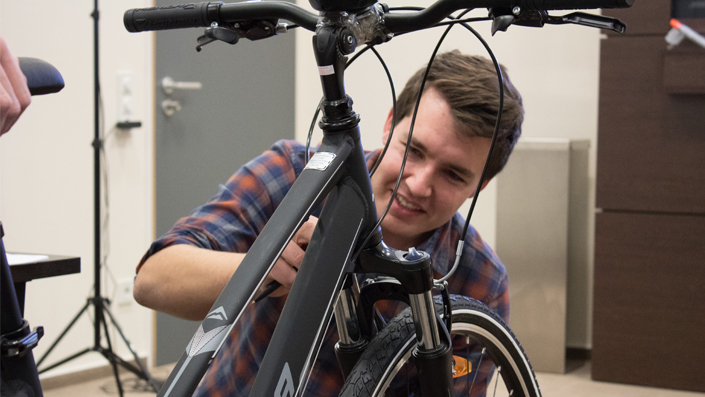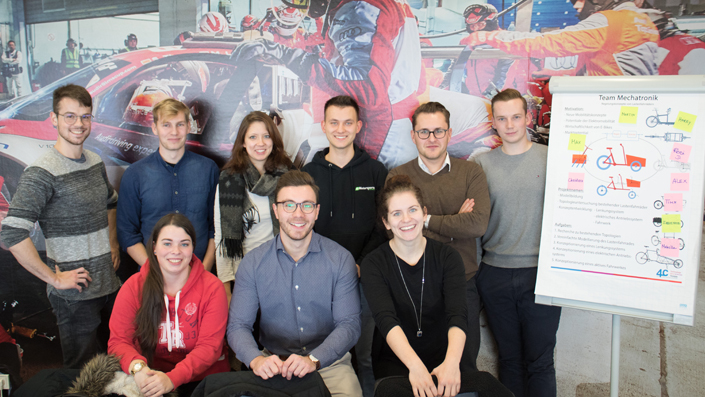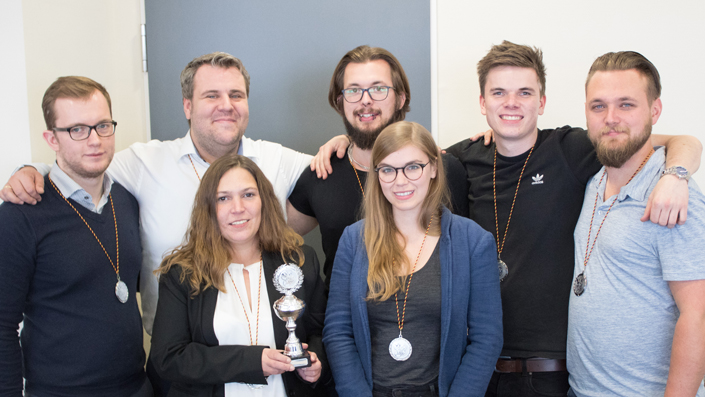Hackathon 2018 at Nürburgring
Invited by Dr. Schmidt, Chairman of the Nürburgring Akademie e.V., the 4C Laboratory arranged a self-organized hackathon at the Nürburgring from November 19 to 21, 2018.
 Hackathon_2018
(Image: CAD CAM CENTER Cologne)
Hackathon_2018
(Image: CAD CAM CENTER Cologne)
This took place under the direction of Prof. Dr. rer. nat. Margot Ruschitzka and Prof. Dr.-Ing. Christoph Ruschitzka. The term "hackathon" is composed of the words "hack" and "marathon" and describes an event in which technology-related tasks and problems are processed within a given time frame.
The participants could not have been more different: this hackathon was cross-gender, cross-age, cross-university, cross-disciplinary and cross-degree. Students from the RWTH Aachen University and the TH Cologne took part, some of whom are in their Bachelor's and some in their Master's degrees. The other team members consisted of master's graduates and doctoral students, thus forming strong units. Despite the heterogeneous levels of knowledge within the teams formed, the cooperation was not difficult, which was due on the one hand to the mutual motivation to achieve a result that was as well elaborated as possible, and on the other hand to the joy of shared tinkering, creative exchange and trying things out.
In total there were three teams, each of which worked on a bicycle-related task: Team Virtual Reality (headed by Fabian Overath, Florian Stürze, René Teitscheid), Team Technomathematics (headed by Laura Anger, Alexander Nüßgen, Fabian Richter) and Team Mechatronics (headed by René Degen, Harry Ott).
The Virtual Reality (VR) team set itself the task of converting a real bicycle into a virtual model and inserting it into a test track in the form of a virtual course. In this way, the virtual and real worlds are connected and a riding experience as realistic as possible can be achieved. VR equipment as well as a bicycle were brought along as accessories, in order to create the possibility to directly test the developed results and to present them afterwards. Thus the time was used to measure the bike brought along and to recreate it in the virtual world as faithfully to the original as possible. At the same time other team members worked on the design of the course. Within the two and a half days an obstacle course with plants and different objects was created from a white room. Not only did these create a more attractive environment, they also presented challenges for the riders, such as completing a short slalom course around traffic cones.
During the hackathon, the Technomathematics Team focused on intelligent SBike Illumination Systems (ISIS). The name was inspired by the Egyptian goddess Isis, patron goddess of all beings, which reflects the basic idea of the project. The team worked on a system that records and evaluates different situations in traffic with the help of cameras and supports the rider or the bicycle to adapt to the given conditions. Two application examples were developed using algorithms from image processing and artificial intelligence. On the one hand, an intelligent road sign recognition system was implemented, which not only recognizes that the driver has just passed a sign, but also which sign it is, and on the other hand, an automatic dimming system was developed, which adjusts the lighting of the bicycle in case of approaching vehicles. Both subprojects were implemented on a single-board computer so that the functionality can be used on the move. In subsequent projects, the areas of application in ISIS are to be expanded and it is planned to customize the system for mobile and easy use on smartphones.
The mechatronics engineers focused on optimizing cargo bikes. The goal was to create a concept for a safe and competitive load bicycle. For this purpose, the work areas were divided into the investigation of the topology of already existing cargo bikes, the creation of a simplified modelling of such a vehicle and the conception of steering systems, electric drive systems and the chassis in order to be able to guarantee a safe ride even with high loads. The aim of the project was to develop new mobility concepts and to show the potentials of electric mobility. At the end of the project, the economic efficiency and market potential of freight vehicles was to be clarified.
After two and a half days of intensive work, a presentation of the results was scheduled, in which the projects were evaluated. The jury responsible for this was made up of Prof. Dr. Margot Ruschitzka, Prof. Dr.-Ing. Christoph Ruschitzka and, on behalf of Nürburgring GmbH, Dipl.-Ing. Alexander Schnobel.
After a descriptive presentation by the VR team about the technical processes and details of their project, juror Alexander Schnobel immediately took a test drive with VR glasses and bicycle. He mastered the course created by the participants perfectly.
The technomathematicians also explained the technical background information with a stimulating presentation of their results. On the one hand, they showed the developed and functioning dimming technology and on the other hand the programmed and error-free road sign recognition. The aim of these techniques is to ensure greater driving safety in road traffic and an improved interactive driver information system.
The Mechatronics Team was able to shine with the creation of a concept for an optimized cargo bike. The members of the team thoroughly explained why they had agreed on exactly this type of bicycle, namely with two front wheels and one rear wheel, and from then on went into detail with a lot of playfulness and imagination. A load bike was designed, which is equipped for all needs and living and working areas. It is very practical and easy to transport, offers an interface to a smartphone and other useful functionalities.
Besides the technical aspect, the social component was an important part of the Hackathon. During the three days, the participants were accommodated in a holiday park near the Nürburgring, where they could live, cook and exchange ideas together. As an additional highlight, the in-house karting track of the Nürburgring was generously made available on one evening, where the participants of the hackathon were allowed to take part in several races.
According to the jury, the teams delivered a neck-and-neck race. In the end, there were only winners; Team Mechatronics, Team Technomathematics, Team VR, the participants and the Nürburgring. The jury spoke of three golden trophies that should have been awarded for this hackathon, as the level of the results and the performances were incredibly high for the short time available. Mr. Alexander Schnobel was visibly impressed and announced that he was not worried about the new generation of technical staff and developers in our country due to the project results and the confident appearance of the participants.
Photos of the Hackathon
 0 / 0
0 / 0
The jury consisting of Dipl.-Ing. Alexander Schnobel, Prof. Dr. rer. nat. Margot Ruschitzka and Prof. Dr.-Ing. Christoph Ruschitzka (from left to right). (Image: CAD CAM Center Cologne)
 0 / 0
0 / 0
Mechatronics team: Top row: Martin de Fries, Max Faßbender, Michelle Geilenberg, Alexander Lerch, team leader Harry Ott, Timm Honrath. Lower row: Fabienne Charl, Team leader René Degen and Christina Ruschitzka (from left to right). (Image: CAD CAM Center Cologne)


